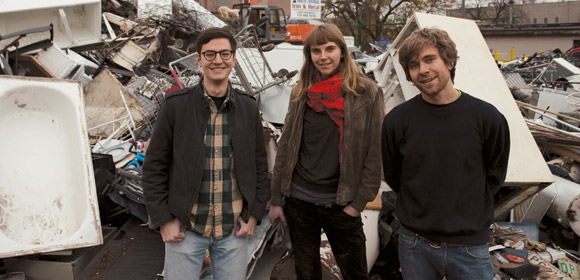
Beyond the Quads
Metal Detectors
Chicago’s alleyways provided inspiration for three young alumni filmmakers.
Ask filmmakers Brian Ashby, Ben Kolak, and Courtney Prokopas, all AB’06, how they met, and they’re not entirely sure. “I didn’t know them at the U of C,” Ashby says.
“No, that’s not true,” Kolak counters. “I lived with Brian for a summer, while I was working on my first feature documentary with one of our mutual friends.”
“You were never there, though.”
And Prokopas and Kolak took a class together, even though Kolak, a full-time videographer and editor, doesn’t remember. “We took Scott Wolniak’s class,” she reminds him, where Kolak made a short about scrappers in Chicago, people who scavenge the city’s alleyways for metal to sell to scrap yards. “I had good things to say about it” in class, says Prokopas, who now works for no-kill animal shelter PAWS Chicago, “but also critical things.”
The short inspired a feature-length project about two scrappers and their families, which the three filmmakers teamed up to do a few months after they graduated. “It seemed like there was a unique sort of entrepreneurial class of people,” says Ashby, who works part time at the University’s South Asia Language and Area Center. “They’re doing something that may or may not be legal or illicit, but people are making lots of money. What is this? Who are they?” They finished Scrappers in 2009, and it won Best Documentary Feature at the 2010 Chicago Underground Film Festival, where the film premiered. In October Roger Ebert, X’70, gave the film 3.5 stars out of four: The filmmakers, he wrote, “put in the hours in the alleys and brought back a human document.”
Ashby, Kolak, and Prokopas didn’t start the project with a clear narrative, or really any idea of where they were going to go. They’d all seen the scrappers driving their pick-up trucks or wheeling shopping carts down alleys, searching for discarded iron, aluminum, or copper, and they originally pursued dozens of potential ideas. They hung out at scrap yards. They thought about exploring the environmental aspects of scrapping, like how it improves on Chicago’s poor recycling system. Another possible focus was artists in the city who incorporated scrap metal into their work. After months of searching for subjects, they found two men who scrap to provide for their families—Otis, a jovial, 73-year-old native Chicagoan living in a public-housing project for seniors with his third wife, Loretta, and her son Adrian; and Oscar, an undocumented Honduran native, with a wife in Spain and children back in Honduras and a girlfriend and son in Chicago: “Una esposa y mujer?” asks one woman who had called on him to pick up some metal from her home. Oscar nods.
Going into filming without a clear vision of a narrative or “trying to meet any bullet points” allowed for “a more ‘authentic’ piece, shaped according to what emerged in the subjects’ lives,” Kolak said after an October Scrappers screening at Chicago’s Gene Siskel Film Center. In fact, the two subjects’ personal and professional lives ended up being the main focus of the documentary, though the film also features interviews with Michael Olive, the owner of Premier Metals Recycling, and a meeting of the Illinois Sheriffs’ Association where the topic was scrap-metal theft (which is rare among scrappers in Chicago, says Kolak—it seems to be more of a problem in rural areas where people don’t put metal out to throw away and scrappers may need to strip a building’s copper wire to make money).
“We began [in 2007] by filming Oscar and Otis working,” Prokopas explained in an interview with the Chicago web publication Gapers Block, “but within literally hours we were welcomed into their homes. It is clear that their family is their major motivation for why they do what they do, meaning collect scrap.” They decided the film would be “a longitudinal piece about them over time,” says Ashby. They spent months doing research and building relationships with Otis, Oscar, and their families, and filmed about 80 hours of footage—“tiny for a feature-length documentary,” says Kolak. Some of those days, Prokopas remembered at the Siskel Center Q&A, they were up with the scrappers at 4 a.m., working in negative-20-degree weather.
The drama happened organically. When the three started their filming, the commodities market was booming, and scrappers could make $300–$400 for a ton of metal, a good living. But by 2008, the price dropped to $20. “None of the scrap dealers or scrappers or us saw what happened coming,” says Ashby. “From a cinematic perspective, you can’t really ask for a better plot twist.”
The economic crash may have affected the entire country, but the documentary, which will be screened at Doc Films January 21 at 7 p.m., is uniquely Chicago. “This film could not have been made anywhere else,” says Ashby. The scrappers thrive here (prices have gone back to the regular average, about one-third of the boom prices in the film), he says, because of a combination of the city’s alleyway grid, “which allows these guys to move essentially unharrassed for most of the day,” a subpar recycling system, and a lax set of laws surrounding scrapping. “It’s illegal to scrap without a junk peddler’s license,” says Ashby, “but it’s a system that’s so unenforced that I doubt most police officers even know about it.”
Prokopas agrees: “There are scrappers everywhere, but I think the characters we found are very Chicago. They represent two large populations that we often don’t hear about, at least not such complete stories from family life, work life, home life, thoughts—we don’t get those deep stories.”
—Ruth E. Kott, AM’07
Photos courtesy of Brian Ashby, Ben Kolak, and Courtney Prokopas

